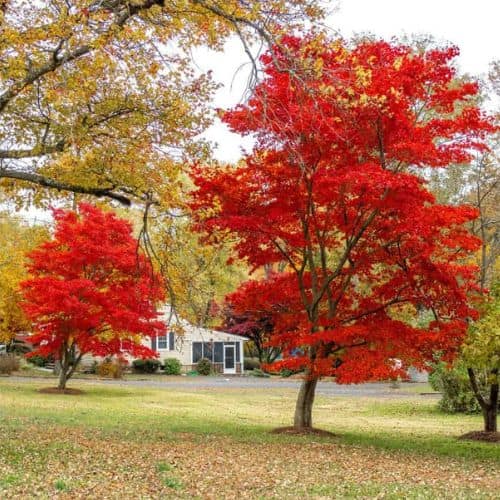Maple Trees, belonging to the genus Acer, are known for their majestic stature and vibrant foliage. These trees are scattered across the temperate zones of the Northern Hemisphere. Maples are synonymous with the changing seasons, orchestrating an annual display of breathtaking colors that transforms landscapes into veritable works of art. From the iconic sugar maple with its brilliant autumnal palette to the silver maple’s graceful branches and the Norway maple’s adaptability to urban environments, the genus Acer paints the natural world with a palette of diversity and elegance.

Growing And Caring For Maples
These trees typically prefer full to partial sunlight. While some species, such as the sugar maple, can tolerate partial shade, ample sunlight is typically necessary for optimal photosynthesis and overall vitality. Maples prefer well-drained soil. They can tolerate a range of soil textures, including loamy, sandy, and clayey soils, but they excel in soils with a slightly acidic to neutral pH. Adequate drainage is crucial to prevent waterlogged conditions. Incorporating organic matter will enhance fertility and improve drainage. A balanced, well-aerated soil sets the stage for healthy root development and robust growth.
Maples are well-adapted to temperate climates and can withstand cold winters and moderate summers. Specific species may have varying cold hardiness, and consideration should be given to the USDA hardiness zone when selecting the right maple for a particular location. Extreme temperatures, especially prolonged periods of intense heat, can stress maples. Adequate water supply during hot and dry spells is necessary.
While maples are relatively resilient, they benefit from consistent moisture, especially in the establishment phase. Deep and infrequent watering encourages the development of a robust root system, enhancing the tree’s ability to access water and nutrients. Mulching around the tree’s base helps retain soil moisture, regulate temperature, and suppress weeds. Striking the right balance and monitoring soil moisture levels contribute to the health and longevity of Maples.
Leaves and Flowers
The leaves of maples are perhaps their most iconic feature, displaying a stunning array of shapes and colors that evolve with the changing seasons. In spring, before the leaves emerge, maples produce inconspicuous flowers that vary in color and structure among species. The flowers, often arranged in clusters called inflorescences, contribute to the visual interest of these trees. As the leaves unfurl, they showcase diverse forms, ranging from simple and palmate to deeply lobed and serrated. The colors of maple leaves span a spectrum of green, red, orange, and yellow, creating breathtaking displays in Autumn.

Size, Shape, and Growth Rate
The growth habit of maples varies from broadly rounded to upright and columnar, creating a wide range of silhouettes that can be tailored to specific landscaping needs. Some species, such as the Sugar Maple (Acer saccharum), can reach towering heights, often exceeding 100 feet. Others, like the Japanese Maple, are smaller and more suitable for compact gardens. The branching patterns of maples contribute to their aesthetic appeal, with some species forming dense canopies and others displaying more open and airy structures.
Maples typically exhibit a moderate growth rate, contributing to their longevity and structural stability. While the growth rate can vary among species, most maples are steady and reliable development. Factors such as soil quality, climate, and available sunlight influence their growth, with well-nourished trees in optimal conditions showcasing the best growth rates. The moderate pace of their development allows for the establishment of robust root systems, contributing to their overall resilience and ability to withstand environmental stressors.
Uses In Gardening And Landscaping
Maples are celebrated for their versatility and find widespread use in gardening and landscaping projects. The variety of sizes, shapes, and colors among maple species allows creative design possibilities in diverse environments. Larger maples, such as the red maple (Acer rubrum) and sugar maple, are often employed as shade trees in residential yards, parks, and streets. Their dense canopies provide relief from the summer sun, creating inviting spaces for outdoor activities.
The silver maple (Acer saccharinum) is another popular species valued for its rapid growth and ability to create quick shade. Its distinctive silver-gray leaves add a unique aesthetic to landscapes. The Norway maple (Acer platanoides) is known for its adaptability to urban conditions and is frequently used in city plantings. Its symmetrical crown and tolerance to pollution make it a favored choice for street trees.
In addition to their ornamental value, maples contribute to ecological balance. The seeds, often encased in distinctive winged structures known as samaras, are a valuable food source for wildlife, including birds and small mammals. The dense foliage provides bird habitat and shelter, contributing to urban biodiversity.

Frequently Asked Questions
When Is The Best Time To Prune Maple Trees?
The best time to prune maple trees is during late winter or early spring before new growth begins. This timing allows the tree to heal quickly from any cuts and reduces the risk of disease transmission. Avoid pruning maple trees during late spring or summer, as this can make them more susceptible to bleeding sap excessively and can attract pests.
Do Maples Produce Acorns?
Maple Trees do not produce acorns. Maple trees are renowned for their vibrant foliage and characteristic winged seeds known as samaras. Unlike oak trees, which bear acorns, maple trees do not produce acorns. Instead, they yield samaras, which are fruits containing one or two seeds. These samaras, often colloquially called “maple keys” or “helicopters” due to their unique shape, develop in clusters after the tree’s flowers are pollinated in the spring.
